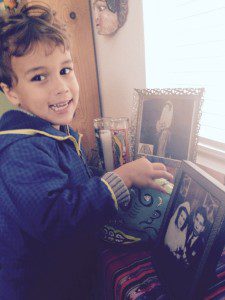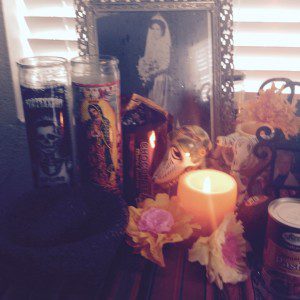Día de los Muertos, or Day of the Dead, is becoming more popular here in San Antonio. The holiday, a celebration of the dead, spans November 1 and 2, with the first day being dedicated to deceased children and the second dedicated to departed adults. There are so many ways to celebrate locally!
But there are also ways to bring the celebration into your own home. For many years, I’ve been making altars to celebrate, and I’ve enjoyed sharing the tradition with my son. Some years I’ve created larger, elaborate altars, and other years they have been smaller and simpler, but the purpose is always the same: to welcome the returning spirits of our family members and friends and remember and celebrate their memory.
It is easy to make your own Dia de Los Muertos altar, and a fun way to keep family memories alive with the next generation. Altars are typically multi-level, but any flat, wide space will do. The ofrendas, or offerings, on the altar are meant to honor and welcome back the deceased. Basics include:
Photographs
Each year when we put out photographs of our loved ones, we go through each one, talk about the person pictured, and tell stories about who he/she was, what he/she was about, and things he/she used to like to do. This has been a beautiful way to help my son stay connected to family members who died before he was born. You can dedicate an entire altar to one person or several, as we do. I also include images of the Virgin Mary, because my grandmother used to insist that I pray to her every night. If you make tiers on your altar, the larger, more formal pictures go on top.
Calaveras
The symbolism is obvious! Sugar skulls are candies made from melted sugar and poured into molds. They are usually decorated with bright colors and sometimes have the names of the deceased written on their foreheads. Papito is still too young to make sugar skulls with me, so we use paper mache for now. I let him pick out which ones to put on the altar, and he takes the job very seriously!
Favorite Foods/Drinks and Personal Effects
Lay out food for the spirits to enjoy! Pan de muerto is a sweet bread that is iconic of the holiday, and we usually put some out on November 1. It’s available at almost any Mexican bakery in town. But we’ll also put out tamales, which both of my grandmothers loved and used to make, and candy and cookies in honor of my great-aunt’s sweet tooth.
I always include the molcajete, or mortar and pestle, my grandmother used almost every day, and lapel pins she used to wear on a regular basis. They’re some of my most tangible memories of her, and they make me smile without fail every year. Don’t forget water and a favorite soda or beer—traveling from the land of the dead can really build up a thirst!
Flowers and Candles
You can put out fresh flowers in vases or scatter their petals. Cempasuchitl, or marigolds, symbolize the holiday. We use paper flowers, and sometimes put fresh flowers out the day of. The fragrance of flower and incense supposedly lure the spirits in. Candles represent hope and are also supposed to help guide the spirits back.
Have fun with it and be creative! Remember, Día de Los Muertos is not necessarily a solemn, grave occasion. The purpose is not to mourn, but celebrate the journey from life to death, and to honor, reminisce, and savor the memory of loved ones. There’s no one “right” way to build an altar, but it should definitely be joyous and happy.















